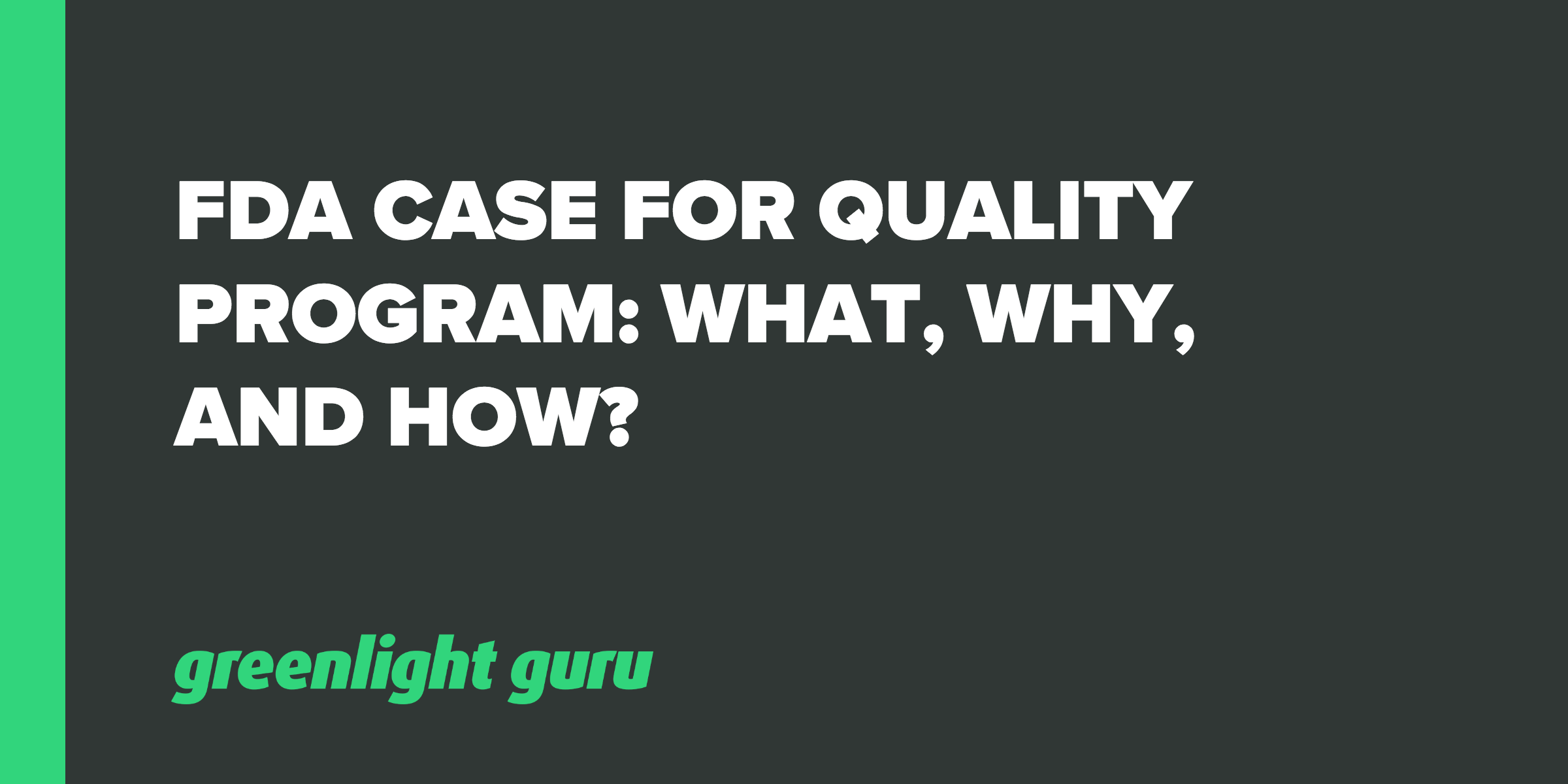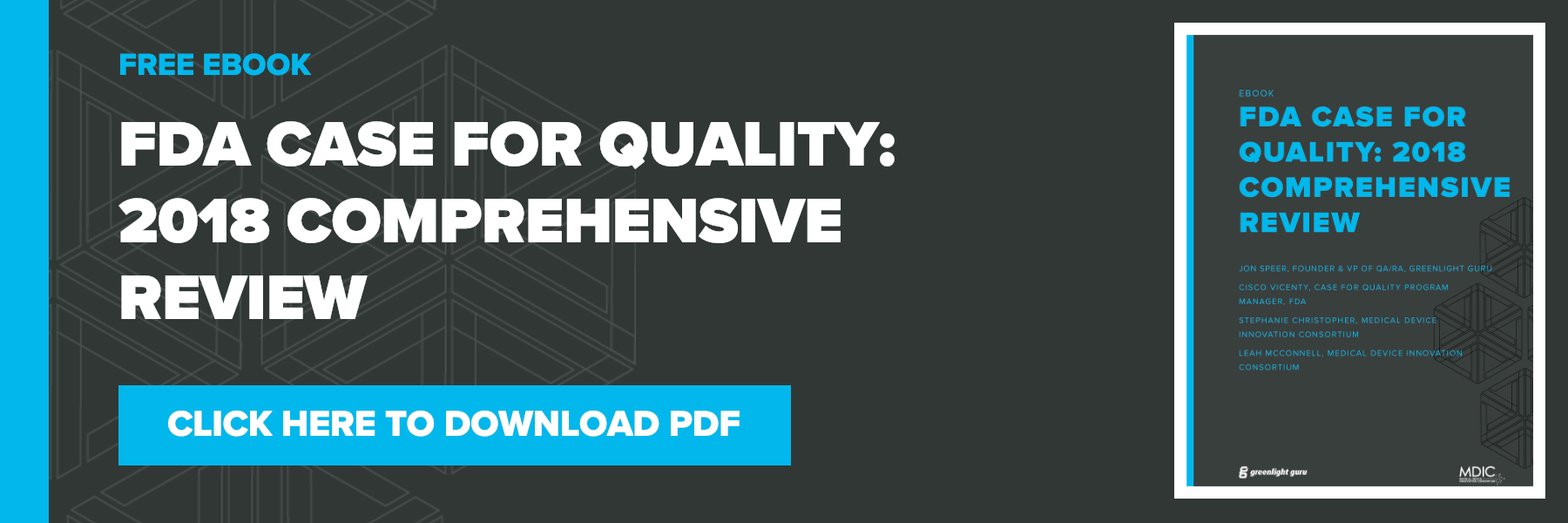
We recently launched a webinar series alongside the FDA, looking at its Case for Quality Program.The Case for Quality program allows the FDA to work with stakeholders—manufacturers, healthcare providers, patients, payers and investors—to shift focus from regulatory-only to a collaborative industry partner. They recognize manufacturers that consistently produce high-quality devices help improve quality of lives of patients.
One thing I really like about Case for Quality is its focus on continuous improvement and producing quality devices, rather than regulatory as a compliance-based “checkbox activity.”
The FDA launched the Case for Quality in 2011 following an in-depth review of device quality data and feedback from both the FDA and industry stakeholders. Since then, they have established mechanisms for stakeholder engagement, developed a Voluntary Manufacturing and Product Quality appraisal pilot and are piloting streamlined submission reviews to support the continuous improvement.
For the first of a four-part series, I spoke with the FDA's Case for Quality Program Manager, Francisco Vicenty, to look at the “what, why and how” of changing the regulatory paradigm.
What is the vision behind Case for Quality program?
To begin with, the Case for Quality program springs from the overarching vision of CDRH:

Source: Cisco Vicenty, FDA Case for Quality Program Manager
It’s important to start here because this vision is the driving force behind how the FDA has shifted its view and how they approach programs.
Why does Case for Quality Matter?
The bottom line is that it’s all about the patient. We need to work together to drive the best possible public health outcomes.
For the FDA, this has meant a dynamic shift of focus to establish what it takes to get there. This means rather than focusing on regulatory as a sort of “checkbox” activity, it’s about a focus on quality.
What does it take?
To shift that focus to one of quality, it really takes the collaboration and engagement of all stakeholders. It’s not enough to say that either the agency or manufacturers are responsible, a whole community needs to be brought into the fold.
Innovation is also key, with a focus on being able to innovate quickly, as well as focus on continuous improvement.
Finally, the regulatory framework needs to be adaptive and responsive in order to enable this innovation and improvement.
Cisco points to some key statistics that help to illuminate why this is so important. With numbers such as these, it’s vital that the agency is able to realistically help to enable quality and innovation.

Why was Case for Quality initiated?
Year after year, the FDA would go out and do inspections of medical device companies, and there would often be 483 observations and/or warning letters for non-compliances as a result. FDA started to notice that the same compliance issues kept coming up, with no real change or improvements.
The FDA did a full analysis in 2010 - 2011, and found that a lot of factors drove the behaviors which lead to this. A predominant focus on compliance was a key one, with three specific issues:
- Industry focus was on meeting regulatory requirements (think "compliance") rather than adopting the best quality practices.
- There was overall low investment in automation and digital technologies. These would help to enable better processes and more responsive learning and action.
- There was no competitive market around medical device quality.
From here, the FDA determined that this was not something they could take on by themselves. They established a collaboration with Medical Device Innovation Consortium (MDIC), geared to tackle these sorts of problems and drive innovation. The aim was to bring all stakeholders together to tackle any barriers and drive the desired outcomes.
What does Case for Quality involve?
The FDA, along with the MDIC, established that what was required was a collaborative effort, focused on organizational excellence and product quality. The FDA learned it needed to be able to adapt its own agility, responsiveness and adaptability to create the right environment for quality.
This might mean simplifying processes, error-proofing them and allowing for continuous, rapid improvement. This also meant that assessment of organizational performance needed to shift from an inspection focus to focusing on quality, and the need to drive connections within quality systems and the organization.
Any processes that might be considered to be overly burdensome needed to be looked at for simplification nd enabling quality outcomes.
The FDA had to really shift its perspective, from compliance to operational excellence.
The pilot program
The FDA’s pilot program has third-party appraisal and was started in January 2018, continuing through to December. It has several participants continuing to sign up at this point.
As part of driving some of the changes they need in the regulatory space and to facilitate continuous improvement along with the pilot program, the FDA made a few adjustments. For example:
- Forgoing surveillance, post-approval and risk-based inspections for pilot program participants. The FDA is getting a more granular knowledge of those companies, which gives it the confidence to allow this.
- It is streamlining manufacturing change notice submissions, with accelerated acceptance going to two business days (versus 30). This may be revisited to move to 5 days.
- Streamlined approval for manufacturing site changes.
- Streamlined approval and forgoing of preapproval inspection from original PMA manufacturing section.
The aim of the changes is to reduce the burden and disruption of inspections, while accelerating the review and approval processes. This shifts resources to innovation and improvement.
Value derived across stakeholders
The FDA looked at stakeholders across the board to see how the Case for Quality program would deliver value. Just among the FDA, 30-day notices consumed 15-22 FTE, which meant the new program could free them up for other activities.
Among manufacturers, there were some marked numbers in terms of top line, annual savings and FTE consumed by regulatory. Under the previous system, they found that submissions were being limited due to regulatory resources, and people were even starting to hold back innovations and ideas. Comparatively, the EU manufacturers were able to move a lot faster in their journey.
With public health outcomes in mind, it’s easy to see the importance of lowering those barriers.

How is a maturity appraisal different?
The focus is really on the practice - how is the work being done? It’s not just looking at regulations, but is very interview-driven.
At this point, they’re not “collecting evidence”, they’re looking to drive maximum value for the organization and the FDA. It’s a more robust inspection with those who are doing the work and is designed to drive internal conversations about improvement.
Voluntary pilot program process
You can check out the application site to find the FDA’s criteria for acceptance. Below is the process that companies go through to get onto and go through the program:

A key goal of the FDA is to get objective metrics from this program. There aren't any particular metrics, but it is trying to understand the landscape of metrics as it applies to companies.
Appraisals are conducted by a third party. There is some document review, but no collection, and appraisers work with organizations to understand their objectives, and determine how they can work to those objectives. In this way, the appraisal becomes a value-add to the organization.
The information collected, what the organization gets and what the FDA gets, is shown below:

The FDA is using this to gather baseline numbers and note any shifts as it moves through the pilot.
Where is it heading?
The FDA wants to get to true visibility or insight as to what’s going on over the whole industry, in any specific product space. This means a shift in how it looks at the information it has, looking to be more objective.
The FDA also needs to know how organizations measure themselves, not to judge the metric, but to understand the approach.
Getting to the “least burdensome” approach is also high on the agenda. Information exchange needs to be improved while processes need streamlining and making more error-proof.
Underscoring all of this is the desire to accelerate improvement and innovation, leading to better patient outcomes.
While the pilot has focused on manufacturing, in the future the FDA would really like to expand to design. It recognizes that some of the same principles apply in the 510(k) space, and it needs to understand how to enable that.
Simplification, a major goal includes aspects like how to increase adoption of technologies that facilitate quality, and how to lean out validation efforts.
A current effort is to streamline and clarify expectations when it comes to non-product computer systems validation. The FDA found a lot of tools were not being adopted due to perceived regulatory burden. So the FDA realized it needed to shift how it communicate these expectations.
Why is this a focus? The use of those systems has the potential to deliver high-value to organizations.
Want to check out the full FDA and Greenlight Guru webinar series? Watch it for free here.
Cisco emphasize that the FDA is always looking for, and open to feedback. I would encourage people to provide it and ask questions - this is how we can collaborate to make those improvements.
Jon Speer is a medical device expert with over 20 years of industry experience. Jon knows the best medical device companies in the world use quality as an accelerator. That's why he created Greenlight Guru to help companies move beyond compliance to True Quality.









